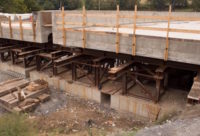The Pennsylvania Turnpike Commission is jumping into accelerated bridge construction (ABC) with both feet, figuratively speaking, undertaking two replacement projects at opposite ends of the Keystone State.
The first project was successfully completed during the weekend of Sept. 22-25, when Brayman Construction Corp., Saxonburg Pa., demolished adjacent 66-year-old, two-span,150-ft-long concrete box beam bridges at the Turnpike’s crossing over Brush Creek in Beaver County, northwest of Pittsburgh.
New 70-ft-wide, 22-in.-deep steel plate-girder structures, designed by SPK Engineering Inc., Uniontown Pa., were rolled into place as a single unit onto the existing two-column piers and abutments with a push system of hydraulic jacks. Interstate 76 was reopened with two hours to spare within the allotted 55-hour closure period.
A second ABC project in Lehigh County in eastern Pennsylvania will take place later this year. At the crossing of the Turnpike’s Northeastern Extension (I-476) over Crackersport Road, Road-Con Inc., West Chester Pa., is scheduled to replace a 60-year-old, three-span, 131-ft steel I-beam structure with single-span steel plate-girder structures designed by the Bethlehem, Pa., office of HDR, Inc.
Although the Pennsylvania Dept. of Transportation has utilized ABC for a variety of structure upgrades for several years, including the Rapid Bridge Replacement public-private partnership, the replacements mark the first applications of the expedited construction method along the turnpike authority's 552-mile toll-road system.
“These projects have been in planning for two years,” says PTC project manager, Wally Wimer, noting that the Beaver County bridge was selected for ABC in part because of its rural location and relatively straightforward design, albeit with a horizontal curve of approximately one degree.
Still, adjacent space to fabricate the replacement structure was limited, requiring Brayman Construction to negotiate with a nearby landowner to build a temporary access road to the site.
“That actually worked better for us because it minimized our impacts to turnpike traffic during construction,” says Tim Taylor, vice president and general manager of Brayman’s Heavy Civil Division.
Because the condition of the condition of the pier and abutment seatings was unknown, the project team planned for a variety of repair contingencies once demolition of the superstructure was complete.
“We had to consider a lot of ‘what if’s’,” says Joshua Farley, operations manager for the Pittsburgh office of STV, Inc., which is providing construction management and inspection for both ABC projects. Following demolition, an inspection found the remaining substructure elements to be in better condition than expected.
“Some minor repairs to the seatings and additional grouting for leveling was all that was needed,” Farley adds.
rayman then pushed the replacement bridges, fitted with temporary diaphragms, into place 18 inches at a time, resetting the jacks after each stroke.
“We jacked the new structure onto the substructure and removed the diaphragms,” Taylor says. “The entire process went quickly, taking only about two hours and 30 minutes.”
Wimers says a somewhat different set of challenges awaits with the Lehigh County project, which has been delayed while minor technical issues with the sliding mechanism are resolved. There, 70-ft-wide single-span bridges will replace existing parallel three-span structures, allowing for deeper superstructures. The replacement structures will be rolled in separately from opposite sides of the highway.
Public outreach has been a particularly critical planning element for both projects, given the need to divert Turnpike motorists on detours of up to 80 miles around the closures. Although weekend traffic volumes in both areas are typically below the weekday average of 30,000 to 40,000 users, Turnpike spokesperson Carl DeFebo says planners had to coordinate the work around major college football games and other events that regularly attract thousands of long-distance travelers.
“There were only a limited number of weekends available for doing each of these projects,” DeFebo says. “We’re using every possible outlet to alert motorists to the closure, and detour routes.”
Nevertheless, the Turnpike is hopeful ABC will prove itself as a viable alternative to conventional bridge replacement methods.
“We like the advantage of relatively brief closures, compared with managing safety and logistics issues over 18 months,” DeFebo says.




Post a comment to this article
Report Abusive Comment